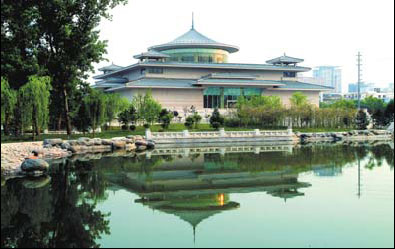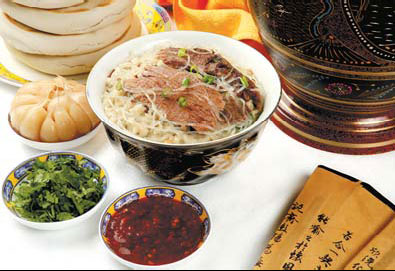
The Xi'an Museum offers tourists better knowledge about the 6,000-year-old city.

Yangrou paomo - or pita bread soaked in lamb soup - is one of the populous snacks in Xi'an. Photos Provided to China Daily
One of the pagoda's many functions was to store the sutras and figurines of the Buddha brought to China from India by the Buddhist translator and traveler Xuanzang (AD 602-664).
Surrounding the city center is a 14-kilometer-long, 15-meter-wide wall built in the Ming Dynasty (1368-1644).
It is the best-preserved ancient city wall in China, and one of the largest ancient military defensive systems in the world.
Today the wall serves as a tourist attraction. On a sunny day, travelers often rent bicycles and enjoy riding on top of the wall that separates the city center from the outside.
Local snacks
As famous as the cultural heritage are the city's characteristic local snacks.
With thousands of years of history growing wheat, Xi'an is home to many kinds of flour-based food. Even the simple noodle has different shapes and tastes.
One of them is called biangbiang mian. It is famous not only for its distinctive taste, but also for the name itself - its Chinese name cannot by typed out on a computer. Even the local people need a pithy formula to remember how to write the characters consisting of dozens of strokes.
Another iconic local snack is roujiamo, which looks like a Chinese version of a hamburger. The simple fast food is believed to have been prepared that way for some 2,400 years.
In an authentic roujiamo, the pork inside is stewed for hours in a soup containing more than 20 kinds of spices and seasonings, then minced into fine shreds and mixed with coriander and mild peppers.
The meat is then stuffed in a mo, a type of flatbread made of wheat flour, and baked in a clay or mud oven.
Many time-honored roujiamo shops are nestled in the small streets in the city center, keeping as low a profile as the city itself.
Only a few blocks from the shops is a Muslim community called Beiyuanmen Street, also known as Fangshang by local residents. There tourists can taste another famous food, yangrou paomo - pita bread soaked in lamb soup.
That neighborhood is also a sightseeing destination featuring many centuries-old mosques built in traditional Chinese - not Middle East - style.
Replicas of the Terracotta Warriors, paper-cutting handicrafts and clay sculptures with color painting are some of the most popular souvenirs for tourists.

Copyright ©1999-2011 Chinanews.com. All rights reserved.
Reproduction in whole or in part without permission is prohibited.